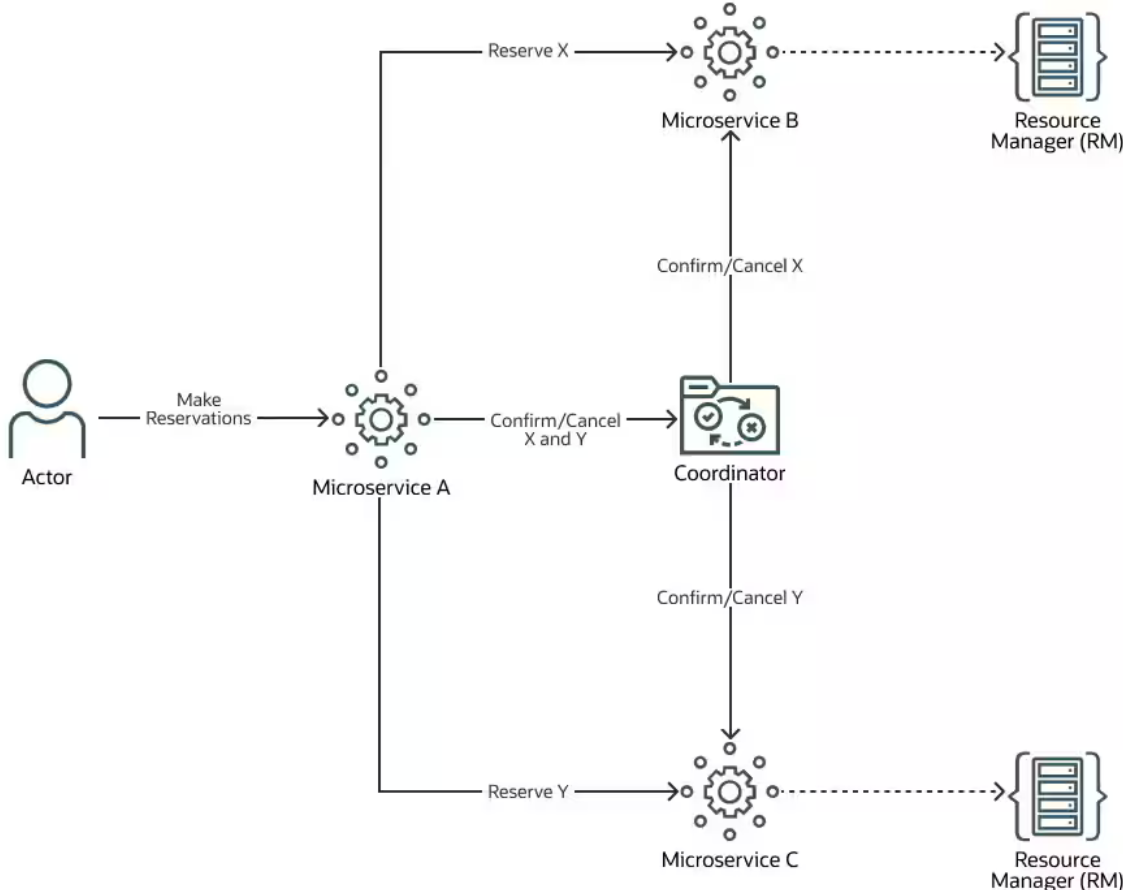1.3.3 Try-Confirm/Cancel Transaction Protocol
The Try-Confirm/Cancel (TCC) transaction protocol holds some resources in a reserved state until the transaction is either confirmed or canceled. If the transaction is canceled, the reserved resources are released and are available in the inventory.
The TCC transaction protocol relies on the basic HTTP verbs: POST, PUT, and DELETE. Ensure that your application conforms to the following guidelines:
- The transaction initiator service must use the
POSTHTTP method to create a new reservation. As a response to this request, the transaction participant services must return a URI representing the reservation. The MicroTx client libraries places the URI in MicroTx specific headers to ensure that the URI is propagated up the call stack. - This protocol relies upon the participant services to ensure that all participant services either confirm their reservations or cancel their reservations. The URIs must respond to the
PUTHTTP method to confirm a reservation, and to theDELETEHTTP method to cancel a reservation.
The following image describes how microservices and MicroTx interact with each other in a TCC transaction.

Microservice A is a transaction initiator service. It starts and ends a transaction. It sends a request to participant services which indicates that the participant service should be part of the transaction.
Microservice B and C are the participant services. These services only join an existing transaction. They do not initiate a transaction.Try Phase
In the TCC protocol, a transaction initiator services asks other participant microservices to reserve resources. During the try phase, MicroTx library collects all the accepted reservations. This includes reservations made by the participant services. By the time the initiator (in the example image above, Microservice A) completes making reservations with Microservice B and Microservice C, the MicroTx library collects all the reservations. At this point the initiator can decide to confirm the reservations, cancel the reservations, or ignore the reservations which would let timeouts eventually cancel the reservations.
Confirm/Cancel Phase
Based on the business logic provided in the initiator service, it can decide to either confirm all the reservations or cancel all the reservations. When the initiator and all participants have acquired the required reservations, the initiator service sends a request to MicroTx to confirm all the reservations. Based on its business logic, if the initiator service decides that it does not want or cannot use the reservations made, it requests the MicroTx to cancel all the reservations. What constitutes a reservation is completely up to the application.
Let us look at a simple microservice that allows reserving and purchasing a seat for a performance. Seats would have a state which could either be AVAILABLE, RESERVED, or SOLD. The try phase would have changed the state of the seat to RESERVED from AVAILABLE. The confirm phase would change the state from RESERVED to SOLD, assuming that payment was made successfully. The cancel phase would change the state from RESERVED to AVAILABLE. To prevent failure of the confirm step when a payment has not been completed successfully, during the Try phase, the microservice should obtain payment authorization to ensure the payment can be made.
Let us consider another example where an application reserves a certain quantity, such as items in an inventory or funds from an account. In this case, during the Try phase the application might deduct the reserved quantity from the available quantity and add a record of the reservation to the database. During the confirm phase, the reservation record is deleted. During the cancel phase, the amount in the reservation record is added back to the total inventory and the reservation record is deleted.
The following steps describe the successful path of a TCC transaction among microservices and MicroTx. In case of failures, the initiator service calls cancel instead of confirm.
- The transaction initiator service, Microservice A, makes a MicroTx client library call to begin the TCC transaction.
- The transaction initiator service invokes
POSTon Microservice B, a participant service, to reserve a resource X. - Microservice B reserves the required resources, and then returns a URI representing its reservation to Microservice A, the transaction initiator.
- The transaction initiator service invokes
POSTon Microservice C, a participant service, to reserve a resource Y. - Microservice C reserves the required resources, and then returns a URI representing its reservation to Microservice A, the transaction initiator.
- Microservice A, the transaction initiator service, calls MicroTx to either confirm or cancel the reservations.
- MicroTx calls
PUTto confirm orDELETEto cancel on all the URIs (reservations) to complete the transaction. - The participant services confirm or cancel the resources, and then return the HTTP response code
200to MicroTx. - MicroTx returns a successful status to the transaction initiator, Microservice A. If MicroTx does not receive 200 status from one or more participants, then it returns an error message.
Parent topic: About the Distributed Transaction Protocols